-
Medical journals
- Career
Histopathologic Changes in Gastroesophageal Reflux Disease. A Study of 126 Bioptic and Autoptic Cases
Authors: A. Chlumská 1,2; L. Boudová 1; Z. Beneš 3; M. Zámečník 1,2
Authors‘ workplace: Šikl’s Department of Pathology, Faculty Hospital, Charles University, Pilsen Czech Republic 1; Laboratory of Surgical Pathology, Pilsen, Czech Republic 2; Department of Hepatogastroenterology, Thomayer Faculty Hospital, Charles Universitiy Prague, Czech Republic 3
Published in: Čes.-slov. Patol., 43, 2007, No. 4, p. 142-147
Category: Original Article
Overview
The histologic diagnosis of reflux esophagitis is still complicated by the lack of a consensus opinion on what is the normal mucosa in the area of the gastroesophageal junction (GEJ). Most authors consider GEJ as the junction between the squamous and the cardiac epithelium. The cardiac mucosa is composed of mucinous or mixed mucinous-oxyntic glands. These glands are in fact indistinguishable from metaplastic mucosa that arises in the distal esophagus in consequence of gastroesophageal reflux (GER). The cardiac mucosa shows invariably chronic inflammatory changes referred to as “carditis”. The cause of “carditis” is GER and/or Helicobacter pylori (HP) infection.
In our series of 120 endoscopic biopsies of the GEJ and distal esophagus the cardia type mucosa (CM) was always present. In 15 cases, it was accompanied by oxyntocardiac mucosa. Both mucosa types showed chronic inflammation that is after exclusion of HP infection regarded as a strong diagnostic sign of the gastroesophageal reflux disease (GERD). In two cases with clinical symptoms of GERD, a few HP were found on the CM. Therefore we diagnosed them as GERD with secondary HP infection. In 17 cases, CM displayed intestinal metaplasia (IM) predominantly of incomplete type and no dysplasia. This IM expressed MUC6 in the glandular zone of the mucosa like it did in the neighboring glands, whereas in the surface and foveolar epithelium the MUC6 was negative or only slightly and focally positive. On the other hand, IM in the surface and foveolar epithelium was reactive for MUC5AC. The positivity and distribution of CK7 and CK20 was very similar in the Barrett’s mucosa, cardiac mucosa and antral mucosa.
In one specimen of esophagus resected for adenocarcinoma, CM with incomplete IM was found in the vicinity of the tumor. Squamous metaplastic epithelium was often seen near the orifices of submucosal esophageal glands in these areas, indicating the metaplastic nature of the glandular mucosa in the distal esophagus. In the GEJ of 5 autopsy cases of children with spastic quadriplegia (age range 7-10 years) CM in a short segment (0.5-3 mm in length), probably of metaplastic origin was identified, showing chronic inactive inflammation.Key words:
gastroesophageal junction – gastroesophageal reflux disease – gastric cardia – carditis – metaplasia of the esophagus – intestinal metaplasia
Labels
Anatomical pathology Forensic medical examiner Toxicology
Article was published inCzecho-Slovak Pathology

2007 Issue 4-
All articles in this issue
- Mesenchymal Tumors of the Ovary and Uterine Corpus. Selected Review
- Intratubular Germ Cell Neoplasia – Review Article
- Histopathologic Changes in Gastroesophageal Reflux Disease. A Study of 126 Bioptic and Autoptic Cases
- Malignant Fibrous Histiocytoma of the Parotid Gland
- Paraganglioma of the Mesenterium: a Case Report
- Czecho-Slovak Pathology
- Journal archive
- Current issue
- Online only
- About the journal
Most read in this issue- Mesenchymal Tumors of the Ovary and Uterine Corpus. Selected Review
- Intratubular Germ Cell Neoplasia – Review Article
- Histopathologic Changes in Gastroesophageal Reflux Disease. A Study of 126 Bioptic and Autoptic Cases
- Paraganglioma of the Mesenterium: a Case Report
Login#ADS_BOTTOM_SCRIPTS#Forgotten passwordEnter the email address that you registered with. We will send you instructions on how to set a new password.
- Career
